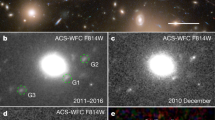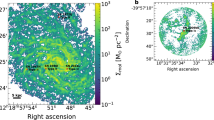Abstract
The recent supernova1 in the Large Magellanic Cloud (LMC), SN1987A, is positionally coincident2–4 with the B3 I supergiant star, Sk–69202. Ultraviolet observations5 of this region made with the International Ultraviolet Explorer satellite after the explosion now show this star to have disappeared. Initial doubts that a blue supergiant could be a supernova progenitor may be overcome by calculations6–8 of the evolution of massive stars at reduced metallicity, as expected in the Magellanic Clouds. These models also account for the relatively low luminosity of the supernova. Here we present an alternative model for SN1987A in which the progenitor was a close binary companion of Sk –69 202.
This is a preview of subscription content, access via your institution
Access options
Subscribe to this journal
Receive 51 print issues and online access
$199.00 per year
only $3.90 per issue
Buy this article
- Purchase on SpringerLink
- Instant access to full article PDF
Prices may be subject to local taxes which are calculated during checkout
Similar content being viewed by others
References
1. Madare, B. & Kunkel, W. IAU Circ. No. 4316 (1987). 2. West, R. M., Lauberts, A., Jorgensen, H. E. & Schuster, H.–E. Astr. Astrophys. (submitted). 3. White, G. L. & Malin, D. F. IAU Circ. No. 4330 (1987). 4. White, G. L. & Malin, D. F. Nature 327, 36–38 (1987). 5. Kifthner, R. P., Nassiopoulos, G. E., Sonneborn, G. & Crenshaw, D. M. Astrophys. J. (in th6 press). 6. Arnett, D. A. Astrophys. J. (in the press). 7. Hillebrandt, W., Hoflich, P., Truran, J. W. & Weiss, A. Nature (in the press). 8. Woosley, S. E., Pinto, P. A. & Ensman, L. Astrophys. J. (submitted). 9. Van ParadijS, J. A. in– Accretion–Driven Stellar X–ray Sources (eds Lewin, W. H. G. & van den Heuvel, E. P. J.) 189–260 (Cambridge University Press, 1983). 10. van den Heuvel, E. P. J. in Accretion–Driven Stellar X–ray Sources (eds Lewin, W. H. G. & van den Heuvel, E. P. J.) 303–341 (Cambridge University Press, 1983). 11. Massey, P. Astrophys. J. 246, 153–160 (1981). 12. Wheeler, J. C, Lecar/M. & Mckee, C. F. Astrophys. J. 200, 145 (1975). 13. Fryxell, B. A. & Arnett, W..D. Astrophys. J. 243, 994–1002 (1981). 14. Arnett, D. A. in Supernovae, A Survey of Current Research (eds Rees, M. J. & Stoneham, R. J.) 235–252 (Reidel, Dordrecht 1982). 15. Karp, A. H., Lasher, G:, Chart, K. L. & Salpeter, E. E. Astrophys. J. 214, 161–178 (1977). 16. McCray, R., Shu'll^J. M. & Sutherland, P. Astrophys. J. 317, L73–L77 (1987). 17. Schwarz, H: E. & Mundt, R. Astr. Astrophys. (submitted). 18. Karovska, M., Nisenson, P., Noyes, R. & Papaliolios, C. IAU Circ. No. 4382 (1987). 19. Illarionov, A. F. & Sunyaev, R. A. Astr. Astrophys. 39, 185–195 (1975).
Author information
Authors and Affiliations
Rights and permissions
About this article
Cite this article
Fabian, A., Rees, M., den Heuvel, E. et al. An interacting binary model for SN1987A. Nature 328, 323–324 (1987). https://doi.org/10.1038/328323a0
Received:
Accepted:
Issue date:
DOI: https://doi.org/10.1038/328323a0
This article is cited by
-
Mechanisms, Models and Laws in Understanding Supernovae
Journal for General Philosophy of Science (2019)
-
SN 1987A and SN 1993J: Testing stellar evolution theory?
Space Science Reviews (1994)
-
Gamma-ray bursts from young supernova remnants
Nature (1990)
-
An alternative binary model for SN1987A
Nature (1989)
-
On the variability of the X-ray emission from supernova 1987A
Nature (1988)



